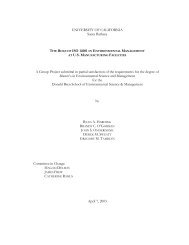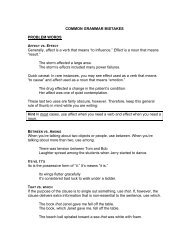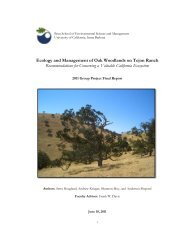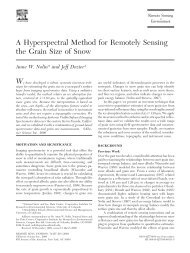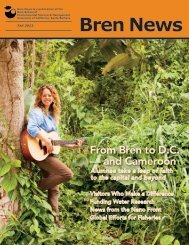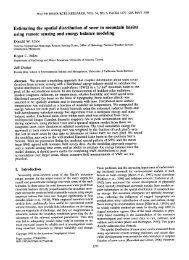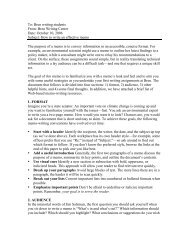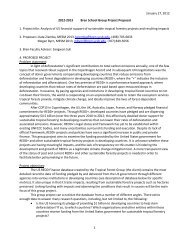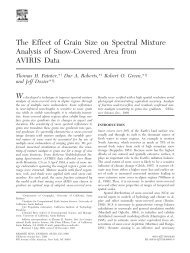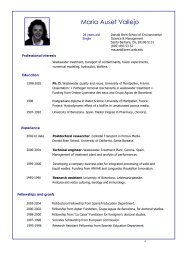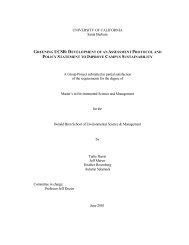Bren News - Bren School of Environmental Science & Management ...
Bren News - Bren School of Environmental Science & Management ...
Bren News - Bren School of Environmental Science & Management ...
You also want an ePaper? Increase the reach of your titles
YUMPU automatically turns print PDFs into web optimized ePapers that Google loves.
<strong>News</strong> Briefs$17 Million Endowment Continues 150-Year LegacyThe <strong>Bren</strong> <strong>School</strong> is thrilled to announce asubstantial gift from the Michael J. ConnellMemorial Fund.Michael J. Connell was born inIreland in 1854 and immigrated to theU.S. as a young man, enjoying significantfinancial success in retail, mining, realestate, and banking. He incorporatedthe Michael J. Connell Charities, Ltd.in 1931 (which ultimately became theMichael J. Connell Foundation) to managehis broad philanthropic interests in thearts and education. But one cause wasespecially dear to him—the environment.Following his death in 1936, the MichaelJ. Connell Memorial Fund was establishedas an independent trust, and the incomededicated to the University <strong>of</strong> California,with no specific direction as to its use.Recently, Richard Wilson, the onlytrustee remaining who has a familialconnection to Mr. Connell, determinedthat the <strong>Bren</strong> <strong>School</strong> should ultimately bethe beneficiary <strong>of</strong> the trust. As a lifelongconservationist, Mr. Wilson has devotedmuch <strong>of</strong> his productive energy to ensuringthat natural resources are utilized in asustainable way so that a given landscapecan be productive for the economicbenefit <strong>of</strong> its inhabitants.Speaking recently with <strong>Bren</strong> <strong>School</strong>dean, Steve Gaines, Mr. Wilson said,“I was keenly interested in shifting thebenefit <strong>of</strong> these funds to the <strong>Bren</strong> <strong>School</strong>,due to its underlying principle <strong>of</strong> bringingtogether the disciplines <strong>of</strong> environmentalscience, business management, policy, andlaw. I know Michael J. Connell would havebeen interested in this from his perspectivein a different era, so I feel that thissupport for the <strong>Bren</strong> <strong>School</strong> carries forwardhis vision and is quite appropriate.”Mr. Wilson believes that it is critical fora respected institution such as the <strong>Bren</strong><strong>School</strong> to have the resources that allow itto provide unbiased scientific informationto decision makers in California and to beavailable to the public at large.Mr. Wilson served as director <strong>of</strong>the California Department <strong>of</strong> Forestryand Fire Protection from 1991-1999.While participating on the front lines <strong>of</strong>environmental policy and conservationduring his tenure, he noticed a pressingneed for environmental solutions toreconcile resource conservation andutilization with the economic forces thatdrive our way <strong>of</strong> life. He was frequentlyfrustrated by the lack <strong>of</strong> capacity in theuniversity system to provide unbiasedadvice to state agencies.His commitment to the environmentand to preserving our natural resourceshas been a central focus <strong>of</strong> his personalphilosophy. At his direction, funds fromthe Michael J. Connell Memorial Fundare to be used by the <strong>Bren</strong> <strong>School</strong> “as itmay determine, with some preferenceto be given to utilizing such distributionsin the area <strong>of</strong> watershed protection, andproductivity and protection <strong>of</strong> forest lands,which are critical to our water supply.”Richard J. Wilson (center), Kim Kimbell (right),and <strong>Bren</strong> Dean Steve Gaines in the <strong>Bren</strong> Hallcourtyard, to be renamed in honor <strong>of</strong> the $17million Michael J. Connell endowment.By directing this endowment to the<strong>Bren</strong> <strong>School</strong>, Mr. Wilson continues a 150-year legacy <strong>of</strong> giving to the University <strong>of</strong>California and begins an unprecedentedcommitment to independent environmentalscience and management education andresearch at UC Santa Barbara.With great appreciation to Mr. Wilson,the courtyard at <strong>Bren</strong> Hall will bededicated to the memory <strong>of</strong> Michael J.Connell in a ceremony at the <strong>Bren</strong> <strong>School</strong>on October 28, 2010.Gift Supports Courses on the Built EnvironmentThe human-constructed environment is responsible for atremendous amount <strong>of</strong> resource consumption and attendantenvironmental impacts.Given that and the fact that <strong>Bren</strong> Hall is a standard-bearer<strong>of</strong> green design, construction, and operation, it is fitting for the<strong>Bren</strong> <strong>School</strong> to play a role in bringing increased sustainability tothe built environment. That work has now begun, thanks to agenerous gift <strong>of</strong> $50,000 from Neil Dipaola, a UCSB alumnusand the CEO <strong>of</strong> Mesa Lane Partners in Santa Barbara, a diversifiedreal estate investment firm specializing in the development <strong>of</strong>environmentally sensitive student and university housing.“Mr. Dipaola’s gift will make it possible for us to begineducational activities that <strong>Bren</strong> has long been hoping to structurebut couldn’t without funding,” said Dean Steve Gaines. “We aredeeply grateful for his generosity, which allows us to take theinitial steps toward reaching that important educational goal.”To begin, opportunities to learn about sustainability in thebuilt environment will come from a series <strong>of</strong> classes taught byexpert practitioners. The first course, Green Buildings: Principles& Practice, is being taught this quarter by <strong>Bren</strong> alumnus BrianHenson (MESM 2003), general manager <strong>of</strong> the sustainabilityfocusedSanta Barbara building firm Allen Associates.<strong>Bren</strong> Web <strong>News</strong>The <strong>Bren</strong> <strong>School</strong> extended its reach on the Internet this past summer, creating a presence on Facebook and Twitter and posting toboth <strong>of</strong> those social-media sites. Become a fan on the Facebook page, and receive <strong>Bren</strong> tweets on your Twitter account at:Facebook: http://www.facebook.com/home.php?#!/pages/UCSB-<strong>Bren</strong>-<strong>School</strong>/137276289632466?ref=tsOr: http://bit.ly/d6NSgUTwitter: http://twitter.com/ucsbbrenschool3
Facultywater sources had on vegetation and erosion.And later, he joined a project to studywhether saline dust kicked up by touristvehicles on a dry lakebed was damagingvegetation. The work involved laying outpaper plates to gather the dust, but a band<strong>of</strong> baboons associated the plates with foodand came out to eat. As the self-described“low man on the biologists’ totem pole,”Dunne had the job <strong>of</strong> “running around inthe dust plume with a big stick to chasethe baboons away.”Dunne describes the twists and turns <strong>of</strong>his career in a way that his simian adversariesin Africa might appreciate: “I climbaround on the theoretical structure <strong>of</strong> geomorphologyas opportunities arise,” hesays, “but I try always to know where I amon the structure, and I select opportunitiesto follow based on that.”Lacking that structural sense, Dunnesuggests, can lead a researcher to settlefor “chasing the money.” He instills in hisstudents the importance <strong>of</strong> “choosing a lifeyou want and then finding the work thatwill get you there, rather than the otherway around.” It’s a regular topic in theseminar he teaches every winter.“We read a paper every week,” he explains,“and over a couple <strong>of</strong> hours we talkabout all these aspects around it: ‘Is this agood scientific problem to work on? Is it agood problem for a PhD thesis? Somethingfor later in life? How would you get the logisticstogether? What collaboration mightbe necessary? What’s the theory?’ Part <strong>of</strong>my job is mentoring and training, and I’dA rented shallow-draft river boat enrichedDunne’s Amazon research experience.like my students to leave here with a hatful<strong>of</strong> research ideas and an ability to generatenew ones and pick which ones to work on.“Ultimately, with my guidance, theypick a juicy, tractable problem they’re willingto bleed for,” he says. “It’s their problem.Then I say, ‘On that problem, you arethe PI and I’m the research assistant. Thisis your chance to make a name for yourselfso that when you get out <strong>of</strong> here, youare known as the person who taught us X;you’re not just the person who producedthree papers for your PhD thesis.”He also warns students against overreaching.“Among the big, important problemsyou could choose, some <strong>of</strong> them arenot solvable right now, and some <strong>of</strong> themare not solvable by you,” he tells them,‘‘You saw thewildlife, and thecamping and fishingwere great. Andthere were just five<strong>of</strong> us on a thousandkilometers <strong>of</strong>uninhabited river,so there was nonegotiating.’’“and some others are not solvable withthe time and resources that any graduatestudent has. So you have to select an importantproblem that is solvable by you inyour status now. You don’t get any creditfor picking an unsolvable problem and pureeingyourself trying to solve it.”Even after securing a project and arrivingin the field to begin working, it can takefocus and effort to ensure that the researchis fulfilling, Dunne explains. His own initialweeks in the Amazon were unsatisfying because,he says, “I didn’t care for being stuckon a boat with not much access to the landscape,or having to negotiate with a pack <strong>of</strong>researchers to secure a boat or other investigatorytools.”So he relocated. “People were concernedabout the effects <strong>of</strong> deforestation on therun<strong>of</strong>f in the Amazon, so I moved into theforest and worked on that,” he says. “Later,I went up into the Andes to look for the sedimentthat was coming in; then we tracedthat sediment down the tributaries <strong>of</strong> theAmazon. We drove and hiked around doingthat intermittently for four or five years.”He and his fellow researchers then wentback down into the main river to addressquestions about how the loading <strong>of</strong> sedimentaffects the river’s behavior.“But this time, we were in charge,” hesays. “We rented a small boat from a localfisherman, so we could stop anywhere wewanted. And every few tens <strong>of</strong> kilometerswe’d get out and machete transects into thefloodplain and take borings into the sediment.It was a much richer aesthetic experience.You saw the wildlife, and the campingand fishing were great. And there were justfive <strong>of</strong> us on a thousand kilometers <strong>of</strong> uninhabitedriver, so there was no negotiating.”In addition to his research, Dunne, likeother <strong>Bren</strong> faculty members, also spendssubstantial time in various advisory rolesfor government agencies. He has acted asa scientific advisor to the United Nations;the governments <strong>of</strong> Brazil, Taiwan, Kenya,Spain, Washington, Oregon, and California;and several U.S. federal agencies. Thatrole does not typically involve conductingnew science. In the 1990s, however, whenconcern over river restoration arose in theU.S., Dunne accepted an advisory positionwith the CalFed Bay-Delta restoration program,a collaboration among 25 state andfederal agencies to improve California’s watersupply and the ecological health <strong>of</strong> theSan Francisco Bay/Sacramento-San JoaquinRiver Delta.The state was going to spend $115 milliona year to restore rivers in the CentralValley by restoring flows, injecting sediment,setting back levees, and letting therivers migrate. But as the committee’swork progressed, Dunne saw a problem.“We did not have the theoretical understanding<strong>of</strong> river behavior to predict whatwould be the outcomes <strong>of</strong> those managementstrategies, but the agencies weregoing to do it anyway,” he recalls. So heproposed to study what would happen ifflows and sediment supplies were alteredand the rivers allowed to migrate.“That led us back to the four elementalforces at work, right?” he says. “And one<strong>of</strong> my students, José Constantine, asked, ‘Ifyou let the river migrate until it cuts <strong>of</strong>f abend, how does that work? And if it cuts <strong>of</strong>fa bend, it leaves an oxbow lake, and theoxbow lake gradually fills up with sediment,and that’s valuable habitat, first for fish,then for aquatic plants, and finally for trees.And that connected my Sacramento Riverwork to our earlier studies on the Amazonfloodplain, where we investigated oxbowlake formation and sedimentation.”It had all come full circle: the theory <strong>of</strong>the four forces, their application in a newenvironment, and the engagement <strong>of</strong> astudent who had learned how to find thebig, tractable problem—all adding up toan opportunity to make another distinctivebreakthrough.5
CurriculumA Broader EcologyIn ESM 201, Frank Davis connects an essential environmental science to thelarger scope <strong>of</strong> solving problems and shaping policyIn the first reading Pr<strong>of</strong>essor FrankDavis assigns for ESM 201, “ManagedEcological Systems,” students learn thatthose who would manage natural ecosystemsneed some ecological knowledge.“Ecology is one <strong>of</strong> the foundationalsciences for environmental science andmanagement,” says Davis, who teachesthe class every fall as part <strong>of</strong> the <strong>Bren</strong>master’s core curriculum.“The goal <strong>of</strong> the course is to ensurethat all our MESM students have a basicunderstanding <strong>of</strong> ecological theory andits application, that they learn the language<strong>of</strong> ecology, and that they understandboth the power and the limitations<strong>of</strong> an ecological perspective for solvingenvironmental problems. The coursegrounds them in ecological principles inthe context <strong>of</strong> environmental policy.”That link to problem solving is unusualfor an ecology course but fits the <strong>Bren</strong><strong>School</strong>’s solution-oriented mission. “Allthe ecology is done through the lens <strong>of</strong>those problems, whether it’s fisheriesmanagement, pest management, agriculturalsystems, global warming, orchanging species distributions,” Davisexplains. “We start with the problem andthen say, ‘If you were an ecologist, howwould you look at this problem?’”The problems are framed as debates,for instance, examining the pros andcons <strong>of</strong> marine reserves as a fisherymanagement strategy. “There’s a lot <strong>of</strong>ecology underneath that question, butstudents will also find out quickly thatthey can’t answer it with only ecology.So that’s where you get into what ecologycan do and what its limits are,” Davissays. The course presents the concepts<strong>of</strong> ecology in an application-rich, interdisciplinarycontext.As in many MESM courses, students in201 write frequently, <strong>of</strong>ten synthesizingOak-land lecture: Frank Davis (right) and Class <strong>of</strong> 2010 master’s students (from left) Shannon Moy,Serra Hoagland, and Andy Shepard identify oak species as part <strong>of</strong> the their Group Project research.in a brief précis the science issues linkedto a particular policy question, such aspest control. “People always say that biologicalcontrol <strong>of</strong> pests has to be betterthan pesticides,” Davis says. “But studentsthen have to consider that thereare actually risks and consequences toturning new species loose in the environmentas control agents. So they readand review papers and then synthesizethe arguments pro and con around thedebate. I’m asking them to understandthat there is <strong>of</strong>ten more than one way tolook at the system.”Another course focus that reflects akey element <strong>of</strong> the <strong>Bren</strong> curriculum isthe importance <strong>of</strong> human values and objectivesin ecological outcomes. “There’sa sense that if you just leave naturealone, it will take care <strong>of</strong> itself,” Davissays. “What we try to point out is thatnature is not normative; it’s dynamic.”He cites Barry Commoner’s classic1970s book The Closing Circle: Nature,Man, and Technology, in which the authormentioned four basic laws <strong>of</strong> ecology,”Davis says. “One was that natureknows best. But that’s not a very helpfullaw anymore. We live in a human-dominatedsystem, and we’re making choicesnow as the most important influence onthe ecology <strong>of</strong> the planet. Everything wedo affects ecological outcomes, and thereare many possible outcomes, so instead<strong>of</strong> ‘nature knows best,’ we get into thequestion <strong>of</strong> ‘what do you want natureto provide?’ There are a lot <strong>of</strong> differentstates in nature that are all equally plausiblein terms <strong>of</strong> ecology. We’re increasinglyfaced with the challenge <strong>of</strong> designingecological outcomes; leaving naturealone is not a choice for us anymore.”The course has sections on energybalance and climate change; sustainabilityand fisheries; species interactions,pest management and the ecology<strong>of</strong> invasive species; community ecologyand range management; forest ecosystemsand disturbance theory; speciesconservation, which includes habitatfragmentation, ecosystem services, andreserve-system design; ecological restoration;and predictive ecology.“The message is, we’re affectingeverything, so we have to think aboutmanaging from local to global,” saysDavis. “It’s a different perspective thanpeople get in a typical ecology course.”6
PhD ResearchWater WorksIn the face <strong>of</strong> world population growth, the need for water is emerging as a key global resourcechallenge—for drinking, as well as for such water-intensive processes as industrialization,agriculture, and energy production. Here, we introduce the water-related research <strong>of</strong> two <strong>Bren</strong>PhD students: Kristin Clark works on preventing and remediating water pollution, while SaraHughes focuses on the role <strong>of</strong> institutions in enacting water conservation strategies.Pollution Remediation:From Bioswales to NanoparticlesFor most students on the PhDtrack, a certain amount <strong>of</strong>machete-through-the-bushtrailblazing comes with theterritory. While some projectsare clear from the outsetand move forward smoothly,others face obstacles rangingfrom technical issues toloss <strong>of</strong> funding caused by aAt a bioswale, Kristin Clark holds abudget crisis. Kristin Clark vial <strong>of</strong> nanoparticles-in-suspension.experienced the latter whilestudying water-pollution mitigation under the guidance <strong>of</strong> heradvisor, <strong>Bren</strong> pr<strong>of</strong>essor Arturo Keller.Clark began her work in 2006, in partnership with Friends<strong>of</strong> the Santa Clara River. The project involved eight bioswalesthat were built to mitigate pesticide pollution and nutrientloading <strong>of</strong> the river—primarily phosphates and nitrates—caused by agricultural run<strong>of</strong>f. Phosphates can cause blooms<strong>of</strong> algae, which eventually die and decompose, robbing thewater <strong>of</strong> essential oxygen, while nitrates, which can end upin groundwater, are linked to cancer in humans.The Santa Clara River bioswales are biologically activeunderground trenches filled with hay bales and coveredover by plants. The hay promotes growth <strong>of</strong> bacteria, and asthe run<strong>of</strong>f water passes through the system, the microbestransform the nitrates into beneficial nitrogen and renderthe phosphates inert. Pesticides settle to the bottom <strong>of</strong> thetrenches, which are lined with clay to prevent them frompenetrating deeper into the ground.The project was part <strong>of</strong> an effort to protect a wetlandadjacent to the Santa Clara River and the wildlife that inhabitit, including such endangered species as the steelhead troutand the red-footed frog. Clark’s approach was novel, becausebioswales are more commonly used to mitigate the effects <strong>of</strong>Administrating Efficiency:Why Agencies Do or Don’t AdaptA report produced by thePacific Institute in 2003titled “Waste Not, Want Not”estimated that up to onethird<strong>of</strong> the water used inCalifornia’s urban centerscould be saved with existingtechnology and at less costthan would be required totap new sources. Fourthyearstudent and FulbrightSara Hughes mines data to find thelogic behind efficiency choices.Scholar Sara Hughes isinvestigating what determines whether urban water agenciesadopt conservation and efficiency measures that can generatesuch impressive savings.Her work focuses on fourteen best-management practices(BMPs)—ranging from usage surveys and plumbing retr<strong>of</strong>itsto high-efficiency appliances and conservation pricing—promoted by the California Urban Water Conservation Council(CUWCC), a quasi-government entity formed in 1991 duringa multi-year drought in California. The council supports nonagriculturalwater users in adapting the BMPs through avoluntary program.Some urban water agencies have joined the program,while others haven’t. Hughes wants to know why. “If you canunderstand what motivates agencies to make the decisionsthey do, then you have a better idea <strong>of</strong> how you mightmotivate them to do things differently,” she says.Her project is based on nineteen years’ worth <strong>of</strong> data fromthe California Department <strong>of</strong> Water Resources’ annual PublicWater System Survey. She gathered the data in Sacramento,and then labeled each <strong>of</strong> California’s water agencies as a“leader” (one <strong>of</strong> the collaborating agencies that establishedthe CUWCC), a “follower,” or a “nonparticipant.” She thencreated a system to code each agency based on eightsee Bioswales on page 8 see Agencies on page 87
PhD ResearchBioswalescontinued from page 7run<strong>of</strong>f from roads and parking lots, not farm land.The trenches were proving effective at reducing nutrientlevels, but before lab tests could be run to determinewhere and how that was occurring, and before Clark couldbegin the part <strong>of</strong> the study involving pesticides, she losther funding, a casualty <strong>of</strong> the 2008 California state budgetcrisis. Even incomplete, the project demonstrated thevalue <strong>of</strong> bioswales in reducing nutrient loads, but ratherthan waiting and hoping for new funding to complete theresearch, Clark decided to start a new project that involvesusing engineered nanoparticles for pollution mitigation.“I wanted something that I could control and support bybeing a TA,” she says. “I didn’t want to depend on outsidefunding.”She found it in “magnetic sorbent remediation,” whichinvolves coating iron nanoparticles with sticky surfactant,then overlaying the surfactant with a silica coating. Thesurfactant attracts the pollutants, which stick to it. The silicacoating is porous, allowing pollutants to pass through it tothe surfactant but preventing iron and the surfactant fromleaching into the system being treated. After the toxinsare taken up by the nanoparticles—in about 15 minutes—amagnetic field can be used to retrieve the iron nanoparticles,which have a much greater magnetic charge than iron in itsnon-nano form and are therefore easier to recover.The use <strong>of</strong> surfactants with nanoparticles has beencriticized previously because huge amounts were requiredfor treatment. But Clark’s procedure addresses those issues.“You can apply less and reuse it,” she says. “You apply theparticles, use their magnetic properties to capture them,clean them by mixing them in an alcohol, and reapply them.”In August, she left <strong>Bren</strong> to spend several months workingfor the U.S. Department <strong>of</strong> Defense, studying magneticsorbent remediation at the Edgewood Chemical Biologicallabs at the Aberdeen Proving Grounds in Aberdeen, Maryland.She is working on chemical-warfare-agent remediation.“It will be something completely different,” she said beforeleaving Santa Barbara. “My work is remediation and fateand transport—where do these pollutants go, and how dowe get them out <strong>of</strong> where they end up? I’ve done studies <strong>of</strong>this kind in the lab, but I’ve always wondered what happensin the real world. So I came to the DoD with that philosophyin mind: How do we treat real-world problems? What’sfeasible? It’s about how to do good stuff with chemistry.”Perhaps now she can put away her machete and movesmoothly down the PhD track.Agenciescontinued from page 7attributes, such as size <strong>of</strong> the customer base, percentage<strong>of</strong> water the agency purchased, and whether it was a cityagency or an independent utility. From there, she mined thedata to identify what determines whether or not an agencydecides to adopt the BMPs.She found, for instance, that municipal agencies tendedto adopt them later, if at all. “Because they’re part <strong>of</strong> anall-purpose government [which handles a range <strong>of</strong> waterandnon-water-related functions], their constituency isinterested in a range <strong>of</strong> policy issues, whereas somethinglike the Goleta Water District has a constituency that isinterested only in water,” she explains. “It’s easier for themto be progressive because they don’t have to worry aboutgetting re-elected on other issues.”Size was also important. “The average agency serving tenthousand people is not very likely to sign on,” she says, “butonce you get up to several hundred thousand or a millionpeople being served, the likelihood that an agency will signon increases by more than fifty percent.”That, plus conversations with water managers, led Hughesto conclude that a lack <strong>of</strong> resources at an agency’s disposalwere a big issue, and that smaller agencies would get onboard if they had some support to do so.“One reason the program is voluntary is because we reallyvalue local control and decentralized water managementin California,” says Hughes, whose advisor is <strong>Bren</strong> <strong>School</strong>pr<strong>of</strong>essor Oran Young, a renowned expert on policy andgovernance. “It’s a big deal here, and it goes back to the ‘firstin time, first in rights’ doctrine established during the GoldRush. There have to be other ways to incentivize the desiredbehavior without undermining that. If there was money forit or other ways <strong>of</strong> building capacity, agencies would do it.“I was right about most <strong>of</strong> what I hypothesized,” she says.“Almost all the things I coded for were having an effect onthe relative willingness <strong>of</strong> a district to adopt new efficiencymeasures. Using those variables, you could predict whetheror not an agency would be an early adaptor.”The drivers she identified can be used to inform policy thatmight include better incentives to get more water agencieson board. And that is Hughes’s goal.“My focus is on institutions and how institutionalized rightsand rules shape outcomes,” she says. “I like it because it’s notalways things we can see or that we’re immediately aware<strong>of</strong>. It’s not so much the obvious politics as the underlyingsystem that runs everything. And to find ways to talk aboutthat is really fascinating.”8
Cover StoryGroup Projects with ImpactCollaborative master’s student works resonate in the real worldNearly fifteen years after it began, the <strong>Bren</strong> <strong>School</strong> master’sprogram continues to be defined by the key elements on whichit was founded: an interdisciplinary approach to environmentalscience and management, a focus on applicationthrough problem solving, an emphasis on collaboration andcommunication, and the rigorous use <strong>of</strong> quantitative skills,tools, and techniques.One final foundational element—the Master’s GroupProject—is perhaps the most important <strong>of</strong> all because itincorporates the others and distinguishes the <strong>Bren</strong> MESMcurriculum. Among the top schools <strong>of</strong> environmental scienceand management, only at <strong>Bren</strong> does every master’s studentspend nine months collaborating with colleagues to addressan environmental challenge for a client.Group Projects are complex and taxing. They requirestudents to demonstrate their grasp <strong>of</strong> theory and mastery<strong>of</strong> skills not by writing a paper or presenting a hypotheticalcase study, but by solving an actual problem. Students muststretch themselves in every way as they research, assess,strategize, develop methodologies, negotiate, compromise,and collaborate to complete the project.The rewards are great. Group Projects make a differencein the world by generating new information and innovativesolutions. Some lead to academic publications, others laythe groundwork for follow-up projects, and others introducetechnology. Group Projects have enhanced efficiency, reducedcarbon footprints, saved money, informed policy, servedcommunities, and contributed to the work <strong>of</strong> corporations andNGOs. They have furthered the sustainability efforts <strong>of</strong> <strong>Bren</strong><strong>School</strong> Corporate Partners while demonstrating the value <strong>of</strong><strong>Bren</strong> students as potential employees.To date, more than two hundred Group Projects have beencompleted. Here, we highlight four from recent years, each<strong>of</strong> which demonstrates <strong>Bren</strong> students’ intelligence, creativity,dedication, tenacity, and ability—as students—to impact theworld far beyond academia.Carbon Neutral: From Ventura to ChinaFor their Group Project, Michael Conrardy, Gavin Feiger, Allison King, Aaron Sobel, andJustin Whittet (all MESM 2010) teamed with <strong>Bren</strong> Corporate Partner AECOM <strong>Environmental</strong> todevelop computer s<strong>of</strong>tware that would “address climate change mitigation at the community scale.”They designed and tested the s<strong>of</strong>tware in cooperation with thecity <strong>of</strong> Ventura. Last June, their work led them to China for astudent-to-student collaboration on climate change mitigationstrategies there.For the Group Project, the students performed cost-benefitanalyses on twenty GHG reduction strategies. They thencombined those results with geographic information in s<strong>of</strong>twarethey named SAFEGUARD, which allows community plannersto tailor an economically viable GHG-reduction strategy thatreflects the specific characteristics <strong>of</strong> their community, fromgeography and open space to budget and established goals.The s<strong>of</strong>tware fills a gap for communities, which are responsiblefor meeting the requirements <strong>of</strong> environmental laws likeAB 32, California’s Global Warming Solutions Act <strong>of</strong> 2006, butmay not know where to start or how to proceed. As the groupwrote in their final report, “SAFEGUARD scales these goals tothe community level, providing cities with targets <strong>of</strong> their own.”“Because <strong>of</strong> the faltering economy and its impact on the citybudget, a study <strong>of</strong> this quality was unlikely to happen prior tothe <strong>Bren</strong> students’ taking it on,” said Ventura <strong>Environmental</strong>Services Supervisor and <strong>Bren</strong> alumnus Joe Yahner (MESM2000). “It provides the city with clear goals and actionablesteps to reduce our carbon footprint.”The group’s advisor was <strong>Bren</strong> pr<strong>of</strong>essor Oran Young, whoheads the Sino-American Working Group (SAWG), which is partnering with Chinese counterpartsto address climate change mitigation. When Young saw the value <strong>of</strong> the SAFEGUARD project, heChina moment: The SAFEGUARDteam (from left) Michael Conrardy,Justin Whittet, Gavin Feiger,Aaron Sobel, and Allison Kingpause pond-side between workingsessions in Jiangsu province.see China on page 109
Chinacontinued from page 9worked with SAWG partners to secure funding for the students’ trip.In China, the students worked with their Chinese counterparts to adjust the s<strong>of</strong>tware to fitChinese economic and political realities so that it could be used to support GHG-reduction strategiesfor the new live-work Suzhou Industrial Park in Jiangsu province, as part <strong>of</strong> China’s “Low CarbonCities” initiative. Changes were made, for instance, to account for heavy industry, which Venturalacks but that is a key driver <strong>of</strong> economic growth in China, and one that accounts for 70 percent<strong>of</strong> GHG emissions in Suzhou. And while climate change mitigation efforts in the U.S. are aimed atkeeping atmospheric GHG concentrations below a specific level <strong>of</strong>—450 parts per million—Chinadevelops its GHG goals as a percentage <strong>of</strong> GDP: the government wants a quadrupling <strong>of</strong> theeconomy while allowing GHG emissions to double.“Being able to talk together puts a human face to the process,” said Conrardy. “The Chinesestudents could see that we care about this, and we could see that they care.”Being in the same room accelerated progress dramatically, the group members said.“We learned how to think about China’s emissions situation in a couple <strong>of</strong> afternoons <strong>of</strong>discussion,” Whittet explained. “If we hadn’t been there, face to face, we would have had to readbooks and books to learn what it’s like on the ground there, and we still might not have known. Thevalue <strong>of</strong> being there together is not measurable.”Cover Story10Designing Marine Protected AreasMarine protected areas (MPAs) have become an important tool <strong>of</strong> fisheries management in California.But the first MPAs were established “on a piecemeal basis rather than according to a coherent planand sound scientific guidelines,” according to the California Marine Life Protection Act (MLPA).Amendments to the Act directed the California Department <strong>of</strong> Fish and Game to establish astatewide network <strong>of</strong> MPAs based on the best available science.For their 2006 Group Project, Allison Chan, Amanda Cundiff,Nadia Gardner, Yvana Hrovat, Lindsay Kircher, and CarissaKlein worked with their advisors, <strong>Bren</strong> associate pr<strong>of</strong>essorBruce Kendall and Satie Airame, policy coordinator for PISCO(Partnership for Interdisciplinary Studies <strong>of</strong> Coastal Oceans), todevelop a comprehensive approach for identifying, implementing,and maintaining MPAs along California’s Central Coast.The interdisciplinary project incorporated marine biology,geography, social science, remote sensing, optimization s<strong>of</strong>tware,plus marine-resource law and policy. The group identified species thatcould benefit from the MPA network; identified and mapped areas <strong>of</strong>conservation value; identified features <strong>of</strong> existing MPAs that maximizecompliance and used them to recommend improvements in MPAdesign; and interacted with government agencies and stakeholders.After completing the project, the team collaborated with Kendall towrite a paper that was published in Conservation Biology in 2008. Earlierthis year, the paper became one <strong>of</strong> just fourteen articles selectedfor a “virtual special issue” <strong>of</strong> the journal to celebrate the InternationalYear <strong>of</strong> Biodiversity. A spin<strong>of</strong>f paper was later published in the journalConservation Letters.The project has echoed through the members’ young careers.For Klein, it helped to define the direction <strong>of</strong> her just-completed doctoral studies in conservationbiology at The University <strong>of</strong> Queensland, in Brisbane, Australia. She has been awarded a three-yearresearch fellowship to continue her research on marine conservation in the Coral Triangle, whichincludes tropical areas <strong>of</strong> the Pacific and Indian Oceans.“Our Group Project certainly prepared me for what I’m doing now,” she says. “I use the sametools and methodologies to conduct my current research that we used in the project. Marxan,a protected-area design tool we used, was developed by the people I work with now, includingPr<strong>of</strong>essor Hugh Possingham.”Since graduating from <strong>Bren</strong>, Klein has been invited to provide advice and training on how todesign and implement marine protected areas in the United Kingdom, Australia, and Malaysia.The Group Project propelled Gardner, who works as the Coast and Estuary Conservation Leadfor the Columbia Land Trust in Oregon, into the volunteer service she performs for the Cape FalconMarine Reserve Community Team. Oregon is currently placing its first marine reserves <strong>of</strong>f theWork performed by the MarineProtected Areas Group Projectteam has contributed to thehealth <strong>of</strong> marine ecosystems inCalifornia (above) and far beyond.Sarah Ann Thompson
coastline. The first two pilot reserves were established in 2010; four more are being evaluated forpossible inclusion, and Gardner serves on the evaluation team for the northernmost <strong>of</strong> them.“The <strong>Bren</strong> Group Project set the stage for my work on establishing the first marine reserves inOregon,” she says.Chan reports that the project was valuable in her work with the Coastal Ocean Values Center,where she studied California coastal economies. “Much <strong>of</strong> our interaction with fishermen and othercoastal-dependent businesses in Morro Bay was influenced by the community’s recent experiencewith the MLPA stakeholder process that was part <strong>of</strong> the Group Project,” she says.She adds that her work on the project qualified her for the <strong>of</strong>fer she received to work on themarine-reserve planning process with the Oregon Department <strong>of</strong> Fish and Wildlife. And in hercurrent role as a policy specialist with Save the Bay, she says, “My knowledge <strong>of</strong> what makes anMPA network effective provides a helpful context for my coastal-pollution prevention work.”“The students performed the first-ever reserve design analysis that simultaneously consideredthe interests <strong>of</strong> both fishermen and non-consuming users, such as scuba divers, while meetingconservation objectives,” says Kendall. “This work has been influential in both the academicliterature on reserve design and in practical reserve planning in places such as Fiji and South Africa.Building on the variety <strong>of</strong> training in the natural and social sciences that the <strong>Bren</strong> <strong>School</strong> provides,the students were able to integrate diverse data in an innovative way that advances the field <strong>of</strong>environmental planning and epitomizes the ideals <strong>of</strong> the MESM program.”Conduit for Sustainable TourismIn 2008, Kristian Beadle, Gia Brazil, Ashley Dean, Lucas Johnson, and Paul Spraycar (allMESM 2009) began a Group Project to support the development <strong>of</strong> sustainable, environmentally sensitivetourism in coastal southern Mexico. This past August, they learned that, thanks in large part totheir ongoing efforts since they graduated, funding would be forthcoming for Phase II <strong>of</strong> Playa Viva,a boutique eco-resort in the state <strong>of</strong> Guerrero.Created as part <strong>of</strong> the Eco-Entrepreneurship focus within the <strong>Bren</strong> master’s program, the team’sbusiness proposition was to establish Coastal EcoVentures, a specialty investment firm that would“provide capital and advisory services to small and medium-sized enterprises that show promisein meeting environmental and social goals but cannot securefinancing from traditional sources,” according to their report.Their initial focus would be on the Pacific coast <strong>of</strong> Mexico.The students developed a business plan and a proprietaryscorecard, called “EcoValuator,” which quantifies a project’senvironmental and social impacts. Their goal is to identifyprojects that combine economic development with social andenvironmental sustainability, and then to secure debt or equitycapital for them.While the students were at <strong>Bren</strong>, they became aware <strong>of</strong> PlayaViva, a small resort then in the planning stages. They visitedthe site during the summer between their first and second yearsat <strong>Bren</strong> to evaluate the resort’s plans. Phase 1, consisting <strong>of</strong> amain lodge and two casitas, is now built.Beadle, who, after graduating from <strong>Bren</strong>, traveled acrossMexico as part <strong>of</strong> a Rotary Foundation Ambassadorial Scholarship,visited the nascent resort earlier this summer. He wroteabout it as a model <strong>of</strong> habitat restoration for the Miller-McCunewebzine (www.miller-mccune.com), citing the resort’s wetlandrestoration, support for a sea turtle nursery, solar-poweredfacilities, permaculture-based wastewater management, andcommunity initiatives, such as sea-salt harvesting.But if Playa Viva is to generate adequate revenue to complete the planned environmental work, itneeds to be larger, and that requires investment. To show the viability <strong>of</strong> the business plan, the studentssupported the resort developer in applying for financing, with Spraycar, in particular, assistingPlaya Viva in scaling up their revenue model.“We helped them develop a vision <strong>of</strong> how big the resort would need to be and what kind <strong>of</strong> servicesthey’d <strong>of</strong>fer in order to be pr<strong>of</strong>itable,” says Spraycar.In August, they received the news that Verde Ventures, an investment fund managed by ConservationInternational, would provide debt financing for the next phase <strong>of</strong> the resort.A stage for sustainability: CoastalEco Ventures group members tourthe foundation for a new buildingat Play Viva, a green resort in theMexican state <strong>of</strong> Guerrero.Cover Storysee Tourism on page 1211
Tourismcontinued from page 11“This is a highlight for our Group Project,” says Spraycar, who now works with the Packard Foundationin Northern California. “Our goal was to create a business that would be successful in the longterm, beyond our time at <strong>Bren</strong>. We identified the project, we found the investors, and we identifiedtheir suitability as partners. Ultimately, they agreed with us. We’ve become more confident that there’sa need for the expertise we gained at <strong>Bren</strong>, and that we’re capable <strong>of</strong> delivering it.”Beadle is currently in Mexico, and this academic year, he will carry on the mission <strong>of</strong> CoastalEcoVentures by conducting research at the Institute <strong>of</strong> Tourism in Huatulco, southern Oaxaca, whilesearching for more real-world opportunities for the fledgling business.“The experience with Playa Viva has given us confidence that we can positively impact the direction<strong>of</strong> coastal development,” he says. “We couldn’t have done it without the mix <strong>of</strong> business andecology we learned at the <strong>Bren</strong> school.”Cover Story“Packaging” life-cycle assessmentPackaging is costly, and not only in financial terms; the environmental burdens <strong>of</strong> packaging manifestthroughout a product’s life cycle, from the acquisition <strong>of</strong> raw materials through manufacturing,distribution, use, recycling, and land-filling. As much as one-third <strong>of</strong> all solid waste in the UnitedStates is packaging.<strong>Bren</strong> <strong>School</strong> Corporate Partner Toyota Motor Sales (TMS), headquartered in Southern California, is aleader in corporate greening but also packages and ships more than 100 million parts every year. TMSasked a team <strong>of</strong> <strong>Bren</strong> students to help reduce the financial and environmental costs <strong>of</strong> its packagingand distribution, which accounts for approximately 70 percent <strong>of</strong> the company’s solid waste.While TMS had previously made gains in this area, prior to the <strong>Bren</strong> Group Project, the tools neededto evaluate the environmental life cycle impacts <strong>of</strong> packagingchoices and facilitate informed design and distribution decisionsin the future were not available to packaging engineers.For their project, Michelle Corti, Claire Early, Tim Kidman,and Wen-Yu Lee (all MESM 2008) worked with their advisor,<strong>Bren</strong> assistant pr<strong>of</strong>essor and industrial-ecology expert RolandGeyer, to design a s<strong>of</strong>tware package called “<strong>Environmental</strong>Packaging Impact Calculator” (EPIC). The s<strong>of</strong>tware combinesfinancial cost and life cycle assessment (LCA) data, enablingToyota engineers to quickly compare the relative merits <strong>of</strong> variouspackaging and shipping options from an LCA perspective.“It’s really remarkable what the students did,” says RyanMcMullan, TMS <strong>Environmental</strong> Programs Administrator anda <strong>Bren</strong> alumnus (MESM 2005). “LCA can be really academic,but they were able to bring all the rigor and expertise <strong>of</strong> theacademic world to something we can use in a practical businesssetting. Whenever a packaging change is considered, the EPICs<strong>of</strong>tware is part <strong>of</strong> that process. It is integral to how we operatenow.”In the past year, EPIC was used by TMS packaging engineers as they considered changing tolighter packaging for windshields. “They used the EPIC calculator to support the other planning andrun an environmental assessment on it,” McMullan says. “With the new packaging, we went fromshipping four windshields at a time to shipping ten with less packaging, generating huge savings interms <strong>of</strong> dollars and environmental impact.”EPIC’s value is extended further thanks to guidelines within Toyota’s “Earth Charter,” which McMullandescribes as the company’s “global environmental compass.” It calls for Toyota to partner with itssupplier companies, many <strong>of</strong> which are too small to have a dedicated environmental department andmay not know where to start in reducing their packaging footprint. “If we can leverage our knowledgeand experience in this area, we can save those companies from having to reinvent that wheel,”McMullan says.The Group Project continues to pay dividends for the <strong>Bren</strong> team members, too. “Working and livingin the world <strong>of</strong> LCA for a year provided me with a new lens through which to view every conceivableissue,” says Kidman, now a policy manager at the California Climate Action Reserve. “It’s notenough to think about immediate impacts or implications; the cascading effects <strong>of</strong> every decision wemake or solution we implement must be weighed carefully.”Packaging at Toyota Motor Sales(above) has a smaller carbonfootprint and costs less thanks tothe EPIC Life Cycle Assessments<strong>of</strong>tware developed by <strong>Bren</strong>students for their Group Project.12
Alumni <strong>News</strong>1999Adam Fischer (MESM) isnow the Municipal Storm WaterPermit liaison for the Santa AnaRegional Board’s Orange CountyPermit. He previously spent sixand a half years as the board’sCWA Section 401 Coordinator.2000Jill Richardson (MESM) hasleft her position as SustainabilityCoordinator/TGIF GrantsManager for UCSB and returnedto graduate school at CSUDominguez Hills in Carson topursue a master’s degree innursing. She hopes to helpgreen the medical industry as amember <strong>of</strong> the Alliance <strong>of</strong> Nursesfor Healthy Environments.2002Andrea (Cohen) Murphy(MESM) celebrated the arrival <strong>of</strong>her son, Cooper Thomas Murphy,on November 9, 2010. Andreaworks in theCorporate<strong>Environmental</strong>ComplianceDepartmentat VerizonWireless.She and herhusband,MichaelMurphy, areraising Cooperin Middlesex,New Jersey.In April, Jota Shohtoku(MESM) left his position as VicePresident – Deputy RegionalLiabilities Group Manager(Southeast Asia) at ChartisInternational and joined AlliedWorld Assurance Company asVice President – Head <strong>of</strong> GeneralCasualty (Asia Pacific). Jota, hiswife, Claudia Anticona (MESM2002), and their 18-month-oldson, Kai, live in Hong Kong.2003Allison Turner (MESM)was recently promoted fromdirector to senior director <strong>of</strong>environmental public affairsat Katz & Associates, acommunity relations and issuesmanagementconsulting firm.2004Since August 2009, Rajendra(Raj) Bose (PhD) has beenManager <strong>of</strong> Research ComputingServices at Columbia Universityin New York. Previously, Raj wasDigital Initiatives Manager forthe Center for Digital Researchand Scholarship within theColumbia University Libraries.Hélène Scalliet (MESM) wasmarried to Steve Graybill inJuly. They met while whitewaterkayaking on the Potomac Riverin 2007, became engagedwhile kayaking in the GrandCanyon, and included a raftingtrip for nearly sixty guests inthe Alleghany Mountains <strong>of</strong>southwestern Pennsylvania aspart <strong>of</strong> their wedding celebration.2005Joshua Levine (MESM) movedhis financial advisory practiceto Royal Bank <strong>of</strong> Canada lastJanuary and joined the SRIWealth <strong>Management</strong> group. OnValentine’s Day, he became dad tohis first child, a son named Skyler.Benjamin Pink (MESM) hasbeen living in Santa Cruz forthe past two years. He left hisposition at Bay Area WaterSupply and ConservationAgency to become the waterconservationmanager for SanJose Water Company. He andhis wife, Shari Lass, had theirfirst child, a son named Jonah,on August 24.2008Amy Locke (MESM) becameengaged to Chris Noddings(MESM 2009) last spring; theyplan to marry in May 2011.Amy is currently working as anenvironmental scientist-biologistat Tetra Tech in Santa Barbara.Jessica Spence (MESM) left hercontracting position with the U.S.<strong>Environmental</strong> Protection Agencyin Washington, D.C., in June, after18 months at the agency. Shespent the summer working on ashorebird ecology project withthe U.S. Fish and Wildlife Servicein the Arctic National WildlifeRefuge, and in August traveledto New Delhi, India, to studyecosystem-based adaptationto climate change through aFulbright Research Fellowship.2009Leslie Abramson (MESM)is currently a NOAA Sea Grantfellow in the U.S. SenateCommerce Committee’sSubcommittee on Oceans,Atmosphere, Fisheries andCoast Guard. She has beenworking on such issues as theDeepwater Horizon oil spill,ocean acidification, fisheriesmanagement, and marinemammalprotection. Sherecently received a SwitzerPr<strong>of</strong>essional Development Grantto travel with the U.S. delegationto the International WhalingCommission in Agadir, Morocco.Kristian Beadle (MESM) spentthree months studying theimpacts <strong>of</strong> climate change onPacific communities during anoverland trip to southern Mexico(www.voyage<strong>of</strong>kiri.com). Inlate July he arrived in Huatulco,Oaxaca, to continue his <strong>Bren</strong>Group Project. (See page 11.)Prior to departing, he completeda year as project manager atMesa Lane Partners in SantaBarbara.After graduating in December,Heather Coleman (PhD)moved to Victoria, BritishColumbia, where she is thescience advisor for the PacificMarine Analysis and ResearchAssociation (PacMARA), a smallNGO promoting the learning andpractice <strong>of</strong> tools for systematicconservation planning andecosystem-based management.Kristine Faloon (MESM)finished her California Sea GrantFellowship at the Monterey BayNational Marine Sanctuary andthen took a job as a scientistwith Seamester, a shipboardstudy-abroad program. Sheteaches marine science andoceanography to undergraduatestudents aboard the 88-footTortola-based S/Y Ocean Star(above), which sails throughoutthe Caribbean.This past summer, ChrisNoddings (MESM) started anew position as an Associate IIin the San Diego–based EnergyGroup <strong>of</strong> <strong>Environmental</strong> <strong>Science</strong>Associates. Chris also proposedto Amy Locke (MESM 2008)last spring; they plan to marry inMay 2011.14



